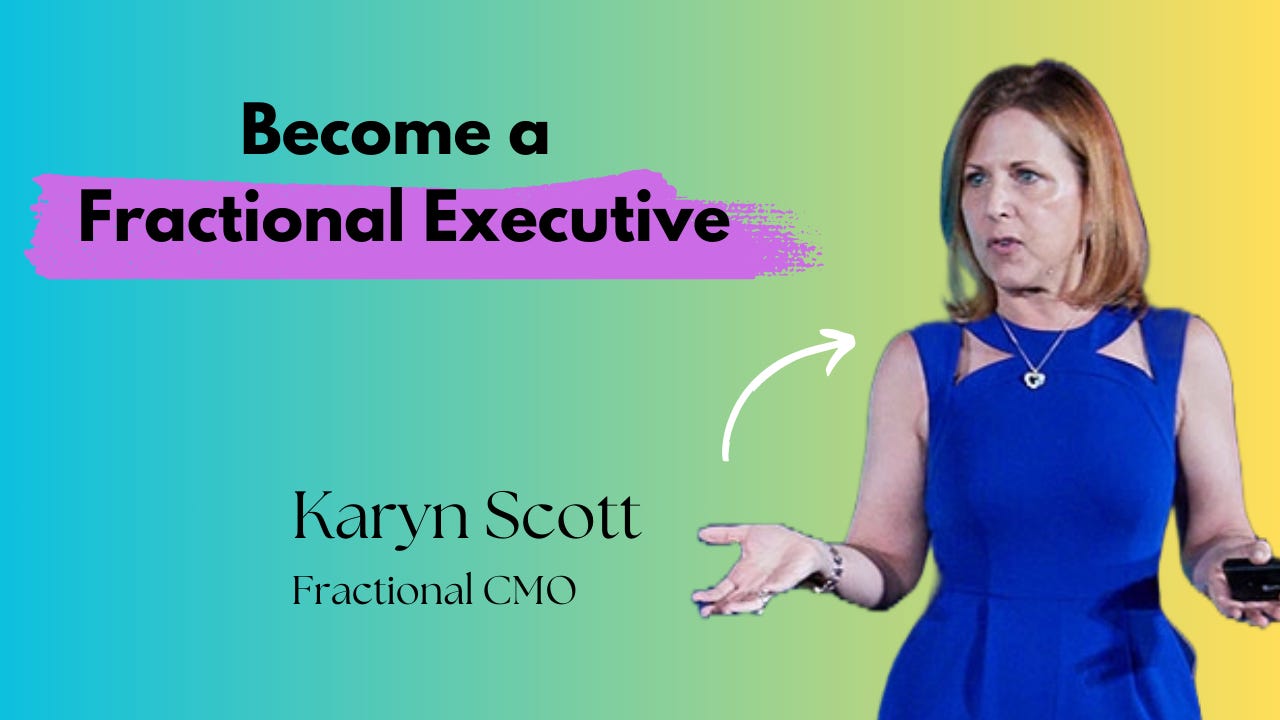AI is Disrupting Jobs - Here’s How to Stay Ahead with Fractional Work
The future of work isn’t full-time—it’s fractional. Karyn Scott, Fractional CMO and founding advisor for Fiat Advisors teaches us how to make the shift before AI forces your hand.
I built a career from helping C-Suite executives transform their businesses. Recently those same C-suite execs have been asking me a simple question:
”How do I future proof my career so I don’t get left behind?”
I recently sat down with Karyn Scott, a seasoned Fractional CMO who has led marketing for Silicon Valley heavyweights like Salesforce, Cisco, and CloudSpot. She’s also a founding advisor at Fiat Advisors, where she helps startups and growth-stage companies sharpen their go-to-market strategies. In our conversation, Karyn shared hard-won insights on building a thriving fractional career, from defining your value to pricing your services and landing clients.
Her advice was so tactical and immediately useful that I decided to turn it into a resource guide for anyone considering fractional work as a way to stay ahead in an AI-disrupted job market.
The AI Job Squeeze is Here
AI is going beyond task automation and having a significant impact on how people look at their work, and it’s leading entire domains to respecialize as new tools simplify and automate work. I spoke about this recently for software engineering.
Some of the key themes emerging from this newsletter include:
The common thread here is that AI is eliminating the “glue work” that held many white-collar jobs together. The result? Fewer full-time roles and a growing demand for specialized, high-impact expertise on a flexible basis.
The good news: companies still need expertise—but they don’t always need (or want) full-time employees.
What is a fractional executive?
According to Karyn Scott, a fractional executive is not just a senior freelancer—it’s a highly focused, strategic leadership role designed to fill a specific gap in a company’s growth trajectory.
Fractional executives provide high-impact expertise on a flexible basis, typically for companies that need executive-level leadership but aren’t ready for (or don’t need) a full-time hire.
I asked if it’s the same as an interim / freelancer role. She emphasizes that while an interim CMO, CFO, or COO temporarily assumes full responsibility for a role, a fractional executive works within a defined scope—whether that’s refining a go-to-market strategy, building a brand foundation, or setting up financial systems. Some fractionals coach and mentor internal teams, while others execute specific, time-bound projects that drive measurable business results.
Karyn’s perspective: Fractional work is about solving high-value problems, not filling seats. Businesses don’t hire fractionals for long-term operations management—they hire them to unlock growth, accelerate change, and bridge expertise gaps.
Why is fractional leadership good for you?
More businesses are looking for on-demand expertise and a fractional CMO is a solution that’s leaner than a full-time marketing team, just as a fractional COO can be more efficient than a bloated operations department. Even technical fields are seeing a rise in AI consultants and fractional AI leads who help companies integrate automation without hiring a full-time staff.
Fractional work isn’t just about staying employed—it’s about staying ahead. It allows you to:
Stay in control. Choose your projects, set your schedule, and avoid getting stuck in AI-driven layoffs.
Charge more for your expertise. Companies will pay a premium for strategic, high-value work.
Diversify income. Work with multiple clients instead of relying on a single employer.
But how do you transition into fractional work? Here’s your step-by-step playbook.
Step 1: Define Your Fractional Value Proposition
Fractional work is about clarity—companies aren’t hiring you for potential; they’re hiring you to solve a defined problem. Your job is to position yourself as the answer to that problem.
1. Identify your high-impact skills
Ask yourself: What do companies need right now that you can deliver in a short timeframe?
Are you a marketing strategist? Companies need go-to-market positioning.
A product leader? Startups need roadmap prioritization.
A finance expert? Companies need fundraising or cash-flow optimization.
2. Narrow your scope
Companies don’t hire fractionals to “do everything.” Get specific.
Instead of “Fractional CMO”, position yourself as “I help B2B SaaS companies refine their GTM strategy and reduce CAC.”
Instead of “AI Consultant”, say “I help companies integrate AI into their workflows without breaking existing systems.”
3. Define success metrics
Companies want outcomes, not effort. Frame your value with real impact:
“I help companies 3x their inbound leads in 90 days.”
“I cut operational costs by 20% through AI automation.”
“I help startups refine their pitch decks and raise $2M+ in funding.”
Tactical takeaway: Write a one-liner that defines what you do, for whom, and the outcome you deliver.
Step 2: Price Your Services Like a Business, Not an Employee
Karyn Scott advises fractional executives to price their services like a business, not an employee. Instead of charging based on what feels comfortable, she suggests using your last full-time salary plus bonus as a baseline, then adding 15-20% to account for overhead like benefits, taxes, and non-billable hours.
To convert this into an hourly rate, divide by 1,000 billable hours per year (since you won’t be working full-time). For example, if your total adjusted salary is $240K, your hourly baseline rate should be around $240/hr, but rounding up for value-based pricing puts you at $250–$300/hr. Beyond hourly rates, Karyn recommends structuring fees through project-based pricing (e.g., $15K for a GTM strategy), monthly retainers ($5K–$10K), or performance-based fees tied to results. Most importantly, don’t underprice yourself—fractional work commands premium rates because companies are hiring you for impact, not hours.
How to Price Your Fractional Work:
💰 Baseline Formula:
Take your last full-time salary + bonus
Add 15-20% (you’re covering your own benefits, taxes, and non-billable hours)
Divide by 1000 billable hours per year (8 hours a day for 220 days per year)
Example:
You made $200K full-time → Add 20% for overhead = $240K
Divide by 1000 billable hours → Hourly rate = $240/hr
Round up to value-based pricing → Charge $250+/hr
Alternative Pricing Models:
Outside of just hourly rates, there are various other pricing strategies you can try depending on the client’s needs.
Project-based pricing → Define a fixed fee for a specific outcome (e.g., $15K for a GTM strategy).
Retainers → Companies pay you monthly for ongoing work (e.g., $5K/month for advisory services).
Performance-based fees → Tie part of your payment to measurable results.
Tactical takeaway: Pick a pricing model that aligns with your expertise + how companies buy services in your field.
Step 3: Find (and Close) Clients Without Feeling Sleazy
Clients don’t come from job boards—they come from strategic networking and visibility.
How to Find Clients:
Start with your past network → Reach out to former colleagues, bosses, and peers.
Position yourself on LinkedIn → Post about your niche, share insights, and make it clear you’re available for fractional work.
Join peer groups → Many fractional executives land work through Slack communities, LinkedIn groups, and private masterminds.
Offer a paid discovery call → Instead of free advice, charge for an initial strategy session ($500-$1,500).
How to Close Clients:
When it comes to pricing your fractional work, Karyn Scott’s biggest lesson is this: sell outcomes, not hours. Companies don’t care how long something takes—they care about the result. If you position yourself as a high-value problem solver instead of just “renting” your time, you can charge what you’re worth and get clients to say yes faster.
Tactical takeaway: Your network is your best lead source. Tell people what you do, who you help, and how to hire you.
Step 4: Set Up Your Fractional Business (Without Overcomplicating It)
You don’t need an LLC on day one—but you do need the basics in place.
Your Fractional Business Checklist:
Website or landing page → A simple Notion or Carrd site works.
Professional email & LinkedIn presence → You are your brand.
Business insurance → Protect yourself with professional liability coverage (~$700/year).
Clear contracts → Use a mutual NDA and simple service agreement (check IndieLaw or Fiverr for templates).
Invoicing software → Use Stripe, Wave, or PayPal to collect payments easily.
Tactical takeaway: Keep it lean—focus on selling, not overbuilding.
Final Thought: AI is Changing Work. Fractional is How You Stay Ahead.
AI is accelerating job shifts at a pace we’ve never seen. The safest move for senior executives worried about job disruption? Position yourself as a high-value, on-demand expert before you’re forced to.
Whether you’re a marketer, a strategist, or an AI consultant, fractional work isn’t just about surviving AI disruption—it’s about thriving in the new economy.
🔥 If this resonated, hit the share button or drop a comment—where are you in your fractional journey?
Watch this week’s episode with Karyn Scott here:



